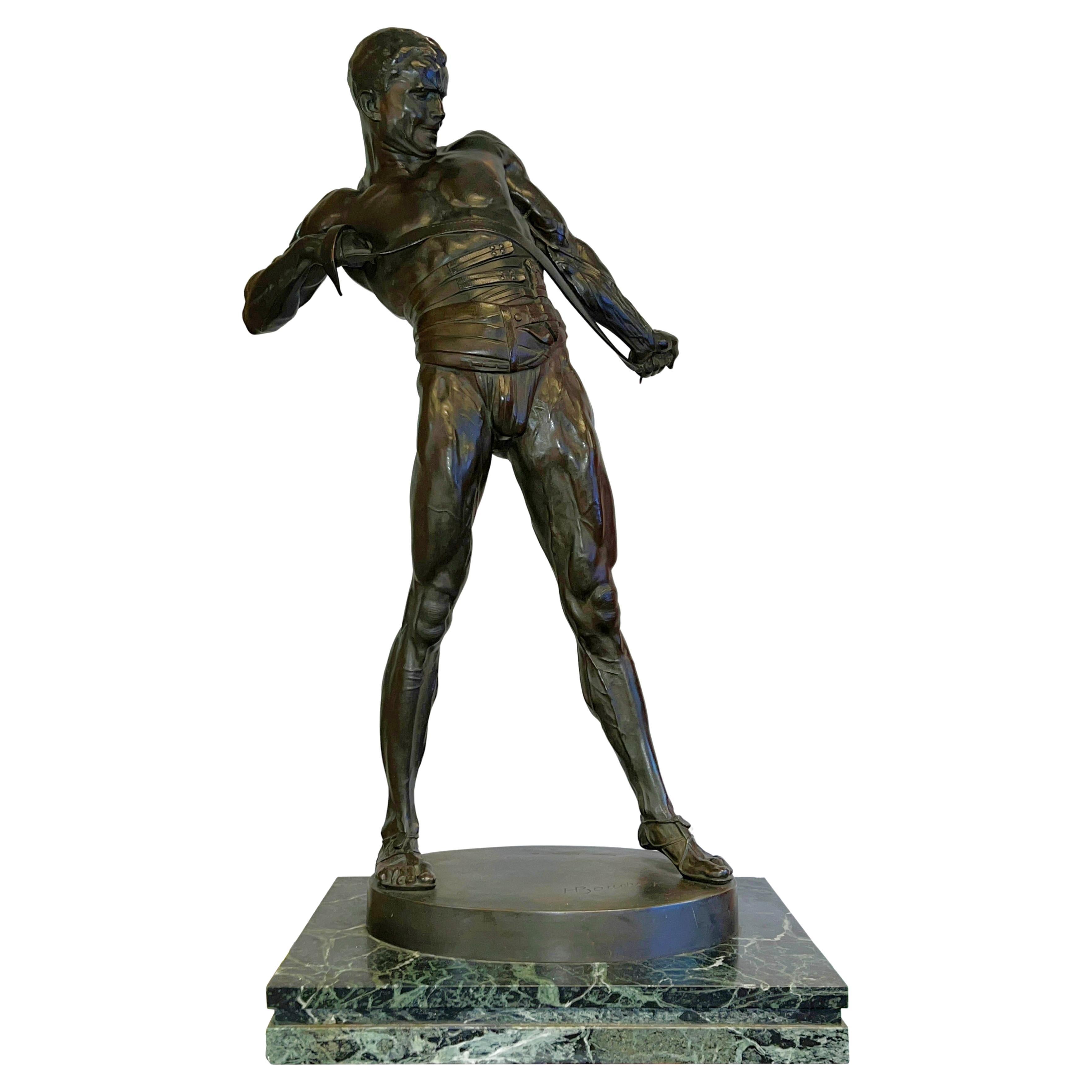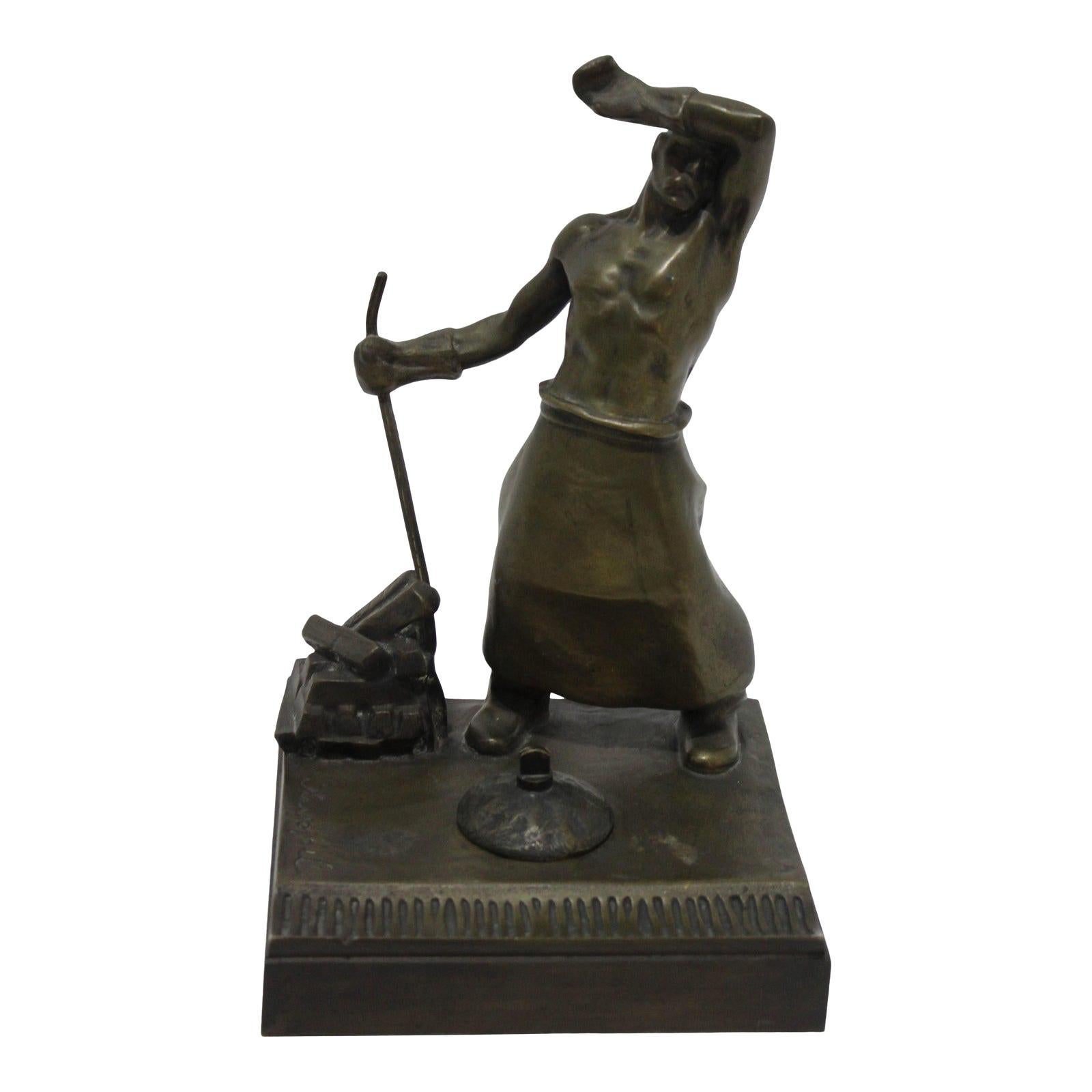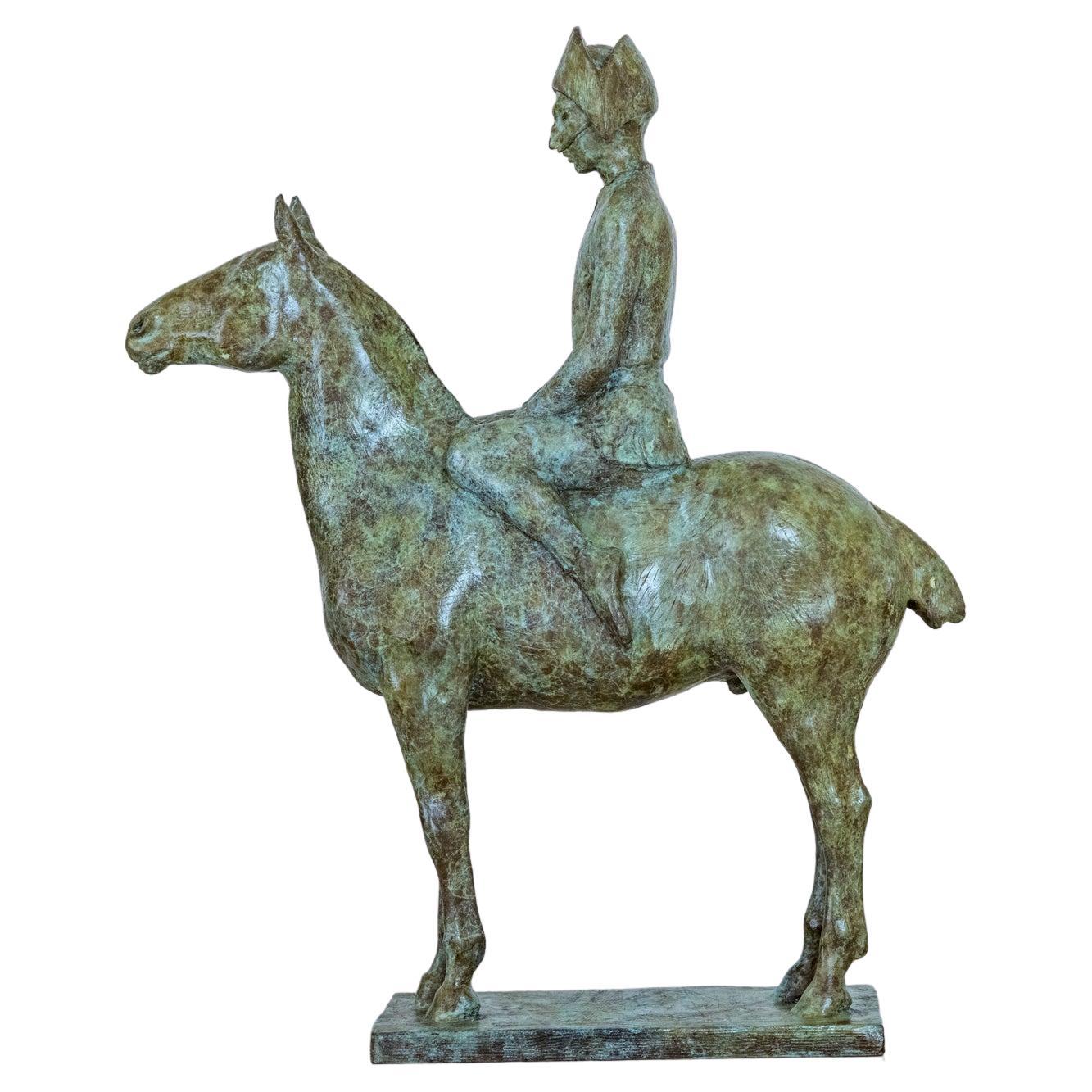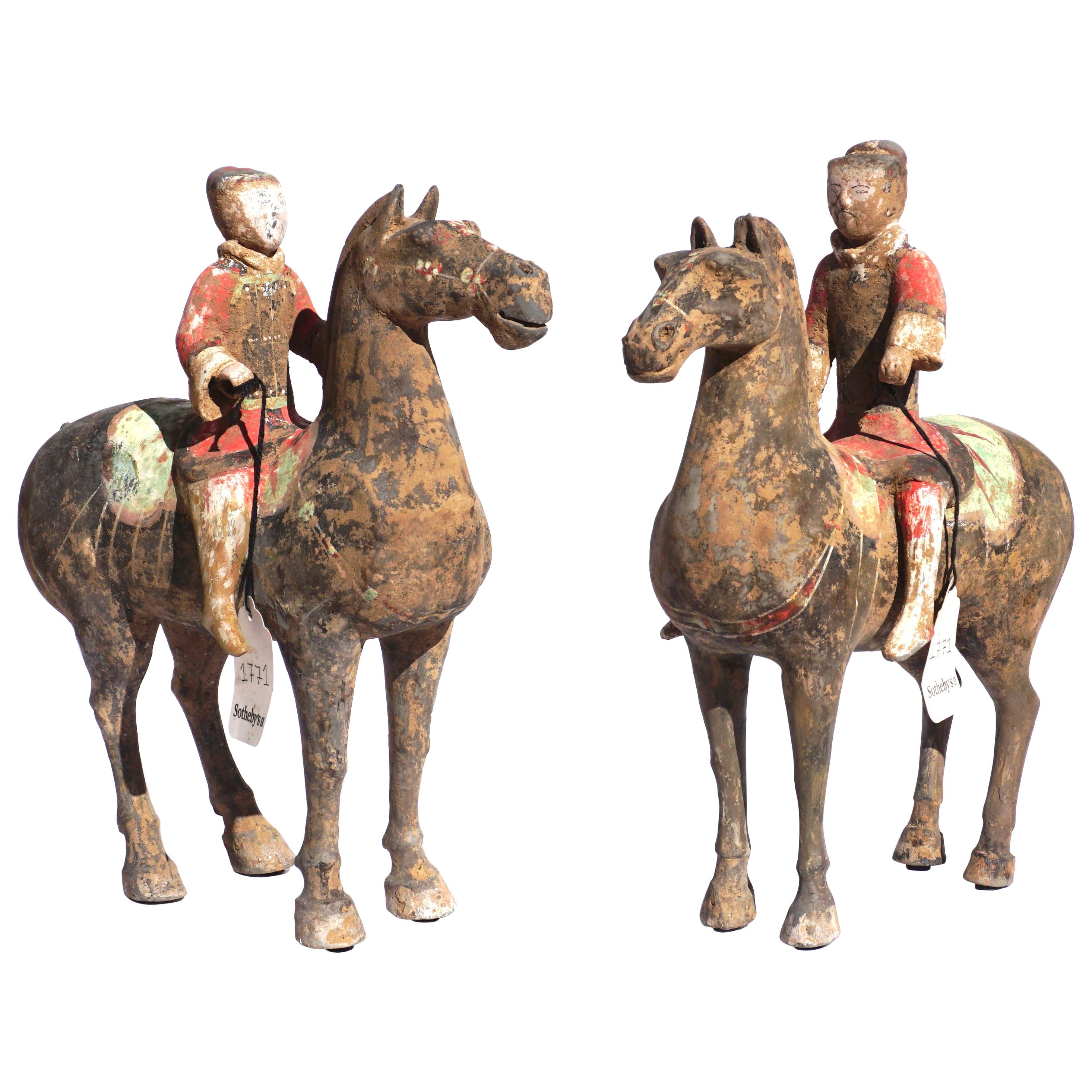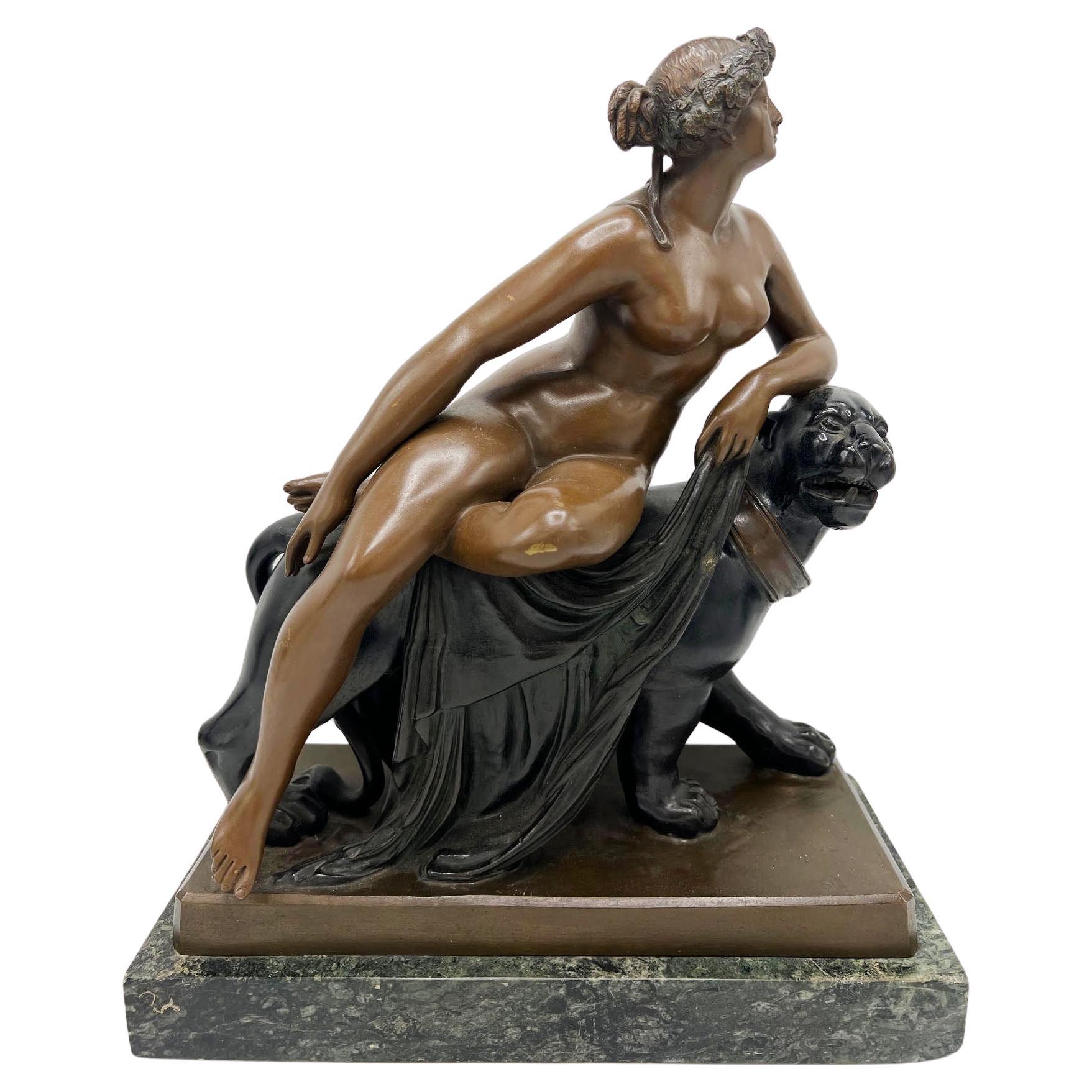Items Similar to Bronze Equestrian Rider by Heinrich Splieth
Want more images or videos?
Request additional images or videos from the seller
1 of 8
Bronze Equestrian Rider by Heinrich Splieth
About the Item
Known as the ‘Olympic Rider’, this patinated bronze group of a man upon a horse is by the German artist Heinrich Splieth. The design is simple yet restrained and refined: an ideal man portrayed in the nude, holding a laurel wreath, is seated on a horse. He is triumphant, his posture, gestures, and countenance carrying classical connotations, a theme highlighted by the wreath he holds. The rider, victorious, symbolises victory. The bronze is signed to the base with ‘Splieth’.
- Dimensions:Height: 17.33 in (44 cm)Width: 17.72 in (45 cm)Depth: 6.3 in (16 cm)
- Materials and Techniques:Bronze,Patinated
- Place of Origin:
- Period:
- Date of Manufacture:Early 20th Century
- Condition:
- Seller Location:London, GB
- Reference Number:
About the Seller
5.0
Recognized Seller
These prestigious sellers are industry leaders and represent the highest echelon for item quality and design.
Gold Seller
These expertly vetted sellers are highly rated and consistently exceed customer expectations.
Established in 1975
1stDibs seller since 2012
361 sales on 1stDibs
Typical response time: 4 hours
Associations
The British Antique Dealers' AssociationInternational Confederation of Art and Antique Dealers' Associations
- ShippingRetrieving quote...Ships From: London, United Kingdom
- Return PolicyA return for this item may be initiated within 14 days of delivery.
More From This SellerView All
- Antique Terracotta Equestrian Model of a HorseLocated in London, GBAntique terracotta equestrian model of a horse Continental, early 20th century Dimensions: Height 37cm, width 46cm, depth 17cm This naturalistically rendered horse sculpture is ...Category
Early 20th Century Belgian Animal Sculptures
MaterialsTerracotta
- Russian cast iron equestrian sculpture of a Cossack soldierLocated in London, GBRussian cast iron equestrian sculpture of a Cossack soldier Russian, 1872 Height 38cm, width 37cm, depth 14cm This fine Russian equestrian cast iron...Category
Antique 1870s Russian Animal Sculptures
MaterialsIron
- Patinated Bronze Angel by FerrandBy Ernest Justin FerrandLocated in London, GBThis patinated bronze sculpture, by the French sculptor Ernest Justin Ferrand, features a female winged figure holding a quill pen and an unfurled scroll of paper. She stands natural...Category
Antique Late 19th Century French Belle Époque Figurative Sculptures
MaterialsMarble, Bronze
- Bronze Orientalist Sculptures by SalmsonLocated in London, GBThis pair of sculptures by Jean Jules Salmson, made of patinated bronze, depicts a male Arab warrior (‘Le Guerrier Arabe’) and a female water carrier (‘La Porteuse’). The male figure presents a dominant posture, his right elbow extending strongly into space. His weapons of war accompany him on his body: the hilt of his sword and handle of his pistol protrude from his sashed waist, and his long rifle...Category
Antique Late 19th Century French Belle Époque Figurative Sculptures
MaterialsBronze
- Belgian Patinated Bronze Bust by LambeauxBy Jef LambeauxLocated in London, GBBelgian patinated bronze bust by Lambeaux Belgian, late 19th Century Measures: Height 63cm, width 35cm, depth 15cm This charming patinated b...Category
Antique Late 19th Century Belgian Busts
MaterialsBronze
- Large Orientalist Bronze Group by BergmanBy Franz Xaver Bergman (Bergmann)Located in London, GBLarge Orientalist bronze group by Bergman Austrian, c. 1910 Measures: Height 28cm, width 18cm, depth 27cm This exceptional bronze group is by Be...Category
Early 20th Century Austrian Figurative Sculptures
MaterialsBronze
You May Also Like
- Roman Gladiator Bronze by Heinrich BauckeLocated in New York, USOur magnificent bronze, entitled Der Gladiator, depicting a Roman gladiator preparing to fight was modeled by the German artist, Heinrich Baucke (1875-1915). Mounted to a green variegated marble plinth measuring 23 by 15 inches and with an overall height of 39 inches. Signed on the base with the stamped mark of the foundry, DUSSELDORFER BRONCEGIESSEREI G.m.b.H. The artist enjoyed a prestigious career. According to the Benezit, Baucke studied under Karl Janssen at the Dusseldorf Academy of Fine Arts. In 1903 Baucke moved to Berlin and executed several commissions for Kaiser Wilhelm II including a major work at the Royal Palace in Berlin (known since the end of the monarchy in 1918 as the Berlin Palace) and supervision of the development of the Schlossplatz palace square. Commissions included the Monument to William I at Rotthausen, the bronze of King Friedrich Wilhelm III of Prussia at the town hall in Elberfeld, a statue of King Frederick I, a stone statue of Maurice of Nassau and marble busts of Helmuth von Moltke, Chief of the German General Staff, and German Chancellor, Otto von Bismarck...Category
Early 20th Century German Neoclassical Figurative Sculptures
MaterialsMarble, Bronze
- Austrian Bronze Desk Set Smelter by Heinrich KrippelLocated in West Palm Beach, FLAustrian Heroic Smelter Worker 20th century bronze sculpture desk set signed by Heinrich Krippel, 1883-1945. Note- Ink container is missing..Category
Early 20th Century Austrian Modern Desk Sets
MaterialsBronze
- Bronze Horse and RiderLocated in Palm Desert, CAThis is a striking bronze sculpture featuring a prominently masked figure much like a harlequin on a horse. the majestic horse stands proud with the rider sitting upright and ready t...Category
Mid-20th Century Mid-Century Modern Figurative Sculptures
MaterialsBronze
- Pair of Han Dynasty Pottery Horses and Equestrian RidersLocated in Dallas, TXA wonderful pair of Ex Sotheby’s painted Polychrome Equestrian Horse and Riders made from gray pottery, Presents beautifully and guaranteed authentic with provenance and COA. Measures: Height 11.5 inches and width 11 inches Condition: Possible professional restorations but not detectable. Provenance: Sotheby’s London. 16th November, 1999. Lot 12 (2 of 4 horses in that lot). Sotheby’s New York, NY September 14, 2019. The importance of the horse in the history and culture of China can be viewed, in part, through the artistic legacy of this great civilization. In sculpture, painting, and literature, horses were glorified and revered. Horses were believed to be related to mythological dragons, reflecting their sacred status within society. During the unification of China under the Han Dynasty, bands of mounted nomadic warriors from the north threatened the country. In order to thwart their attacks, the Chinese sought to import stronger, faster steeds from Central Asia (as opposed to the Mongol ponies used by the invaders), eventually leading to the creation of the Silk Road. This small sculpture of a mounted soldier reveals the crucial military role of the horse. When compared to the diminutive stature of the rider, the importance of the horse becomes readily apparent. This creature provided security and strength, allowing the Empire to secure its borders and expand its influences across Central Asia. The magnificent regalia of the horse, including a brilliantly painted saddle in red and green/gold, reflect the respect this animal received. The warrior as well is gorgeously decorated with a painted red tunic and gray chest...Category
Antique 15th Century and Earlier Chinese Chinoiserie Animal Sculptures
MaterialsPottery
- Pair of Han Dynasty pottery Horses and Equestrian RidersBy Emile GalléLocated in Dallas, TXA wonderful pair of Ex Sotheby’s painted Polychrome equestrian horse and riders made from gray pottery, presents beautifully and guaranteed authentic with provenance and COA. Measures: Height 11.5 inches and width 11 inches Condition: Possible professional restorations but not detectable. Provenance: Sotheby’s London. 16th November, 1999. Lot 12 (2 of 4 horsed in that lot) Sotheby’s New York, NY September 14, 2019. AVANTIQUES is dedicated to providing an exclusive curated collection of Fine Arts, Paintings, Bronzes, Asian treasures, Art Glass and Antiques. Our inventory represents time-tested investment quality items with everlasting decorative beauty. We look forward to your business and appreciate any reasonable offers. All of our curated items are vetted and guaranteed authentic and as described. Avantiques only deals in original antiques and never reproductions. We stand behind our treasures with a full money back return if the items are not as described. The importance of the horse in the history and culture of China can be viewed, in part, through the artistic legacy of this great civilization. In sculpture, painting, and literature, horses were glorified and revered. Horses were believed to be related to mythological dragons, reflecting their sacred status within society. During the unification of China under the Han Dynasty, bands of mounted nomadic warriors from the north threatened the country. In order to thwart their attacks, the Chinese sought to import stronger, faster steeds from Central Asia (as opposed to the Mongol ponies used by the invaders), eventually leading to the creation of the Silk Road. This small sculpture of a mounted soldier reveals the crucial military role of the horse. When compared to the diminutive stature of the rider, the importance of the horse becomes readily apparent. This creature provided security and strength, allowing the empire to secure its borders and expand its influences across Central Asia. The magnificent regalia of the horse, including a brilliantly painted saddle in red and green/gold, reflect the respect this animal received. The warrior as well is gorgeously decorated with a painted red tunic and gray chest...Category
Antique 15th Century and Earlier Chinese Han Animal Sculptures
MaterialsPottery
- Bronze Sculpture "Ariadne" Model by Johann Heinrich von DanneckerBy Johann Heinrich von Dannecker 1Located in Autonomous City Buenos Aires, CABABronze sculpture model "Ariadne" by Johann Heinrich von Dannecker Beautiful sculpture that shows the goddess of hunting half-naked on a panther, in patinated bronze with a marble bas...Category
Antique 19th Century German Belle Époque Figurative Sculptures
MaterialsMarble, Bronze
Recently Viewed
View AllMore Ways To Browse
Used Equestrian
Equestrian Gold
Antique Equestrian Equestrian
Antique Equestrian
Early Rider Used
Bronze Victory
Equestrian Objects
Gold Laurel Wreath
Equestrian Theme
Laurel Wreath Bronze
Equestrian Decorative Objects
Equestrian Bronze
Patinated Bronze Horse
Bronze Equestrian Sculpture
Equestrian Sculptures
Wreath Sculpture
Horse And Rider Sculpture
Heinrich Gold
